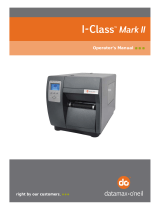
i
Copyright Information
CG Triumvirate is a trademark of Agfa Corporation.
CG Times based upon Times New Roman under license from the Monotype Corporation.
Windows is a registered trademark of the Microsoft Corporation.
All other brand and product names are trademarks, service marks, registered trademarks, or
registered service marks of their respective companies.
Limitation of Liability
In no event shall Datamax-O’Neil be liable to the purchaser for any indirect, special or
consequential damages or lost profits arising out of or relating to Datamax-O’Neil’s products, or
the performance or a breach thereof, even if Datamax-O’Neil has been advised of the possibility
thereof. Datamax-O’Neil’s liability, if any, to the purchaser or to the customer of the purchaser
hereunder shall in no event exceed the total amounts paid to Datamax-O’Neil hereunder by the
purchaser for a defective product.
In no event shall Datamax-O’Neil be liable to the purchaser for any damages resulting from or
related to any failure or delay of Datamax-O’Neil in the delivery or installation of the computer
hardware, supplies or software or in the performance of any services.
Some states do not permit the exclusion of incidental or consequential damages, and in those
states the foregoing limitations may not apply. The warranties here give you specific legal rights,
and you may have other legal rights which vary from state to state.
Firmware (Software) Agreement
The enclosed Firmware (Software) resident in the Printer is owned by Licensor or its suppliers and
is licensed for used only on a single printer in the user’s Trade or Business. The User agrees not
to, and not to authorize or permit any other person or party to, duplicate or copy the Firmware or
the information contained in the non-volatile or programmable memory. The firmware (Software)
is protected by applicable copyright laws and Licensor retains all rights not expressly granted. In
no event will Licensor or its suppliers be liable for any damages or loss, including direct, incidental,
economic, special, or consequential damages, arising out of the use or inability to use the
Firmware (Software).
Information in this document is subject to change without notice and does not represent a
commitment on the part of Datamax-O’Neil Corporation. No part of this manual may be
reproduced or transmitted in any form or by any means, for any purpose other than the
purchaser's personal use, without the expressed written permission of Datamax-O’Neil
Corporation.
Important Safety Instructions
This printer has been carefully designed to provide many years of safe, reliable performance. As with all types
of electrical equipment, however, there are a few basic precautions you should take to avoid hurting yourself
or damaging the equipment:
• Carefully read the provided installation and operating instructions.
• Read and follow all warning instruction labels on the printer.
• Place the printer on a flat, firm, solid surface.
• Make sure all openings on the printer remain unblocked; never insert anything into the openings or
ventilation slots.
• Do not place the printer near a heat source.
• Do not use your printer near water, or spill liquid into it.
• Be certain that your power source matches a listed voltage rating for the printer (if unsure, check with
your dealer or local utility company).
• Do not place the power cord where it can be stepped on; and, if the power cord becomes damaged,
immediately replace it.
• If service is required, use only qualified trained technicians to repair your printer.
All rights reserved. Copyright © 2013, Datamax-O’Neil
Part Number 88-2357-01, Revision C




















